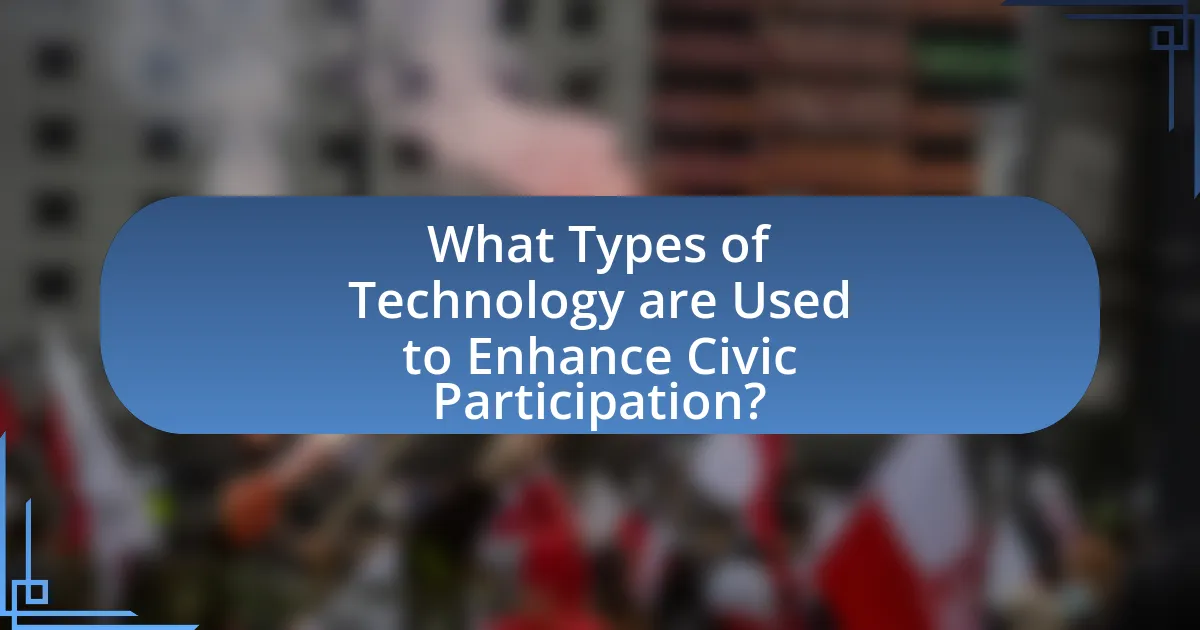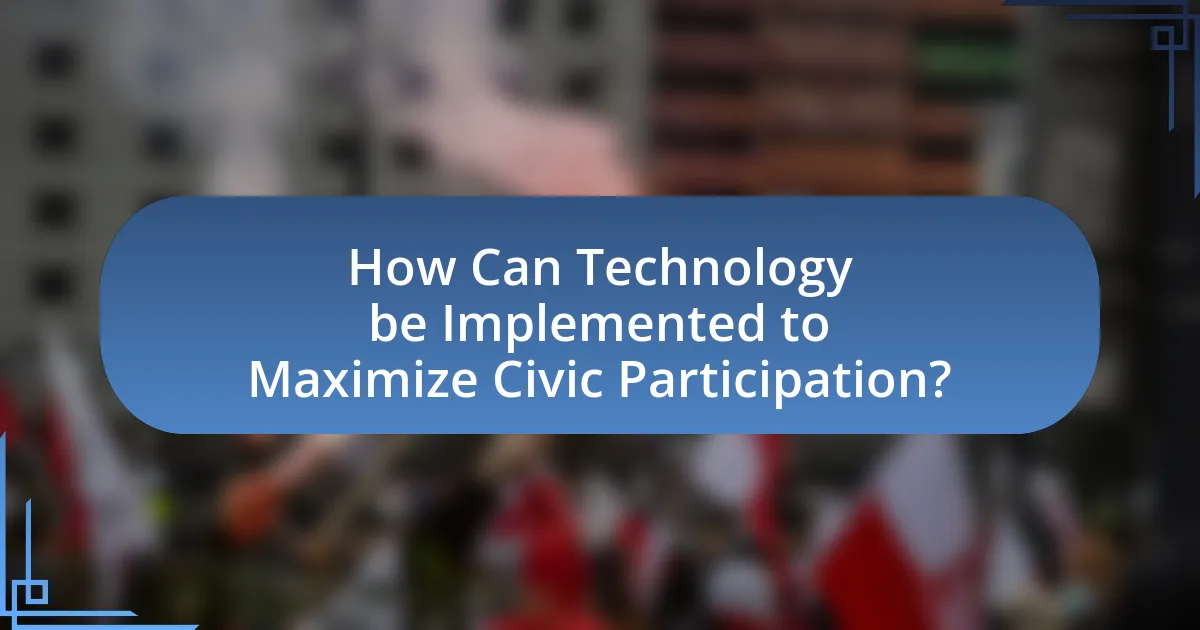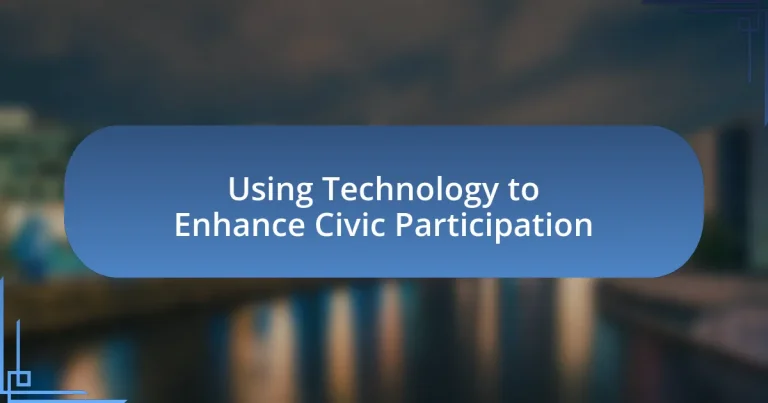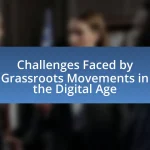The article focuses on the role of technology in enhancing civic participation, highlighting how digital tools such as social media, mobile applications, and online platforms facilitate communication, information sharing, and engagement between citizens and government entities. It discusses the importance of civic participation in a democratic society, the consequences of low engagement, and how technology can improve communication and policy-making. Additionally, the article examines various technologies, including artificial intelligence and blockchain, that are shaping civic engagement, while addressing challenges such as the digital divide and privacy concerns. Practical strategies for organizations and individuals to leverage technology for increased civic participation are also outlined.
What is Technology’s Role in Enhancing Civic Participation?
Technology plays a crucial role in enhancing civic participation by providing platforms for communication, information dissemination, and engagement. Digital tools such as social media, online forums, and mobile applications facilitate real-time interaction between citizens and government entities, allowing for greater transparency and accountability. For instance, a study by the Pew Research Center found that 69% of adults in the U.S. use social media to engage with political content, demonstrating how technology fosters political discourse and mobilizes community action. Additionally, e-governance initiatives enable citizens to access services and participate in decision-making processes more efficiently, further strengthening democratic engagement.
How does technology facilitate civic engagement?
Technology facilitates civic engagement by providing platforms for communication, information sharing, and mobilization. Digital tools such as social media, websites, and mobile applications enable citizens to connect with each other and with their representatives, fostering dialogue and participation in democratic processes. For instance, according to a 2020 Pew Research Center study, 53% of Americans reported that social media helped them become more involved in local issues, demonstrating the effectiveness of technology in enhancing civic participation. Additionally, online petitions and crowdfunding platforms empower individuals to advocate for causes and gather support efficiently, further illustrating how technology serves as a catalyst for civic engagement.
What tools are commonly used to promote civic participation?
Digital platforms, social media, and mobile applications are commonly used tools to promote civic participation. These tools facilitate communication, information sharing, and community engagement, enabling citizens to connect with each other and with their local governments. For instance, platforms like Facebook and Twitter allow users to organize events, share civic-related content, and mobilize support for various causes. Additionally, mobile apps such as Nextdoor and Citizen provide localized information and foster neighborhood discussions, enhancing community involvement. Research indicates that social media can significantly increase political engagement, with a study by the Pew Research Center showing that 69% of adults in the U.S. use social media, which can lead to higher levels of civic participation.
How do these tools improve communication between citizens and government?
These tools improve communication between citizens and government by facilitating real-time interaction and feedback. Digital platforms, such as social media and government websites, enable citizens to voice concerns, access information, and engage in discussions directly with officials. For instance, a study by the Pew Research Center found that 70% of Americans believe social media helps them connect with their local government, enhancing transparency and accountability. This direct line of communication fosters a more informed citizenry and encourages civic engagement, ultimately leading to more responsive governance.
Why is civic participation important in a democratic society?
Civic participation is crucial in a democratic society because it empowers citizens to influence decision-making and hold leaders accountable. Engaging in civic activities, such as voting, attending town hall meetings, or participating in community organizations, fosters a sense of ownership and responsibility among individuals. Research indicates that higher levels of civic engagement correlate with improved governance and policy outcomes, as seen in studies by the Pew Research Center, which found that active participation leads to more representative and responsive political systems. Thus, civic participation not only strengthens democracy but also enhances the effectiveness of governance.
What are the consequences of low civic engagement?
Low civic engagement leads to weakened democratic processes and reduced community well-being. When citizens are less involved in civic activities, such as voting or attending town hall meetings, there is often a decline in political accountability and representation. Research indicates that low participation can result in policies that do not reflect the needs or desires of the community, as seen in studies by the Pew Research Center, which found that higher civic engagement correlates with more responsive governance. Additionally, communities with low civic engagement often experience social fragmentation, decreased trust in institutions, and lower levels of public investment, ultimately hindering social cohesion and progress.
How does civic participation influence policy-making?
Civic participation significantly influences policy-making by enabling citizens to express their needs and preferences, which policymakers can then incorporate into their decisions. When individuals engage in civic activities, such as voting, attending town hall meetings, or participating in public consultations, they provide valuable feedback that reflects the community’s priorities. For instance, studies have shown that areas with higher levels of civic engagement often see policies that better align with the public’s interests, as evidenced by the 2018 National Civic Engagement Survey, which found that communities with active civic participation reported a 30% increase in policy responsiveness. This demonstrates that civic participation not only empowers citizens but also leads to more effective and representative governance.

What Types of Technology are Used to Enhance Civic Participation?
Various types of technology enhance civic participation, including online platforms, mobile applications, social media, and data analytics tools. Online platforms, such as civic engagement websites, facilitate communication between citizens and government officials, allowing for feedback and participation in decision-making processes. Mobile applications enable users to access information about local issues, report problems, and engage in community initiatives directly from their smartphones. Social media serves as a powerful tool for mobilizing communities, sharing information, and organizing events, significantly increasing public awareness and involvement. Data analytics tools help governments and organizations analyze public sentiment and engagement trends, allowing for more targeted and effective civic initiatives. These technologies collectively foster greater transparency, accessibility, and engagement in civic processes.
What digital platforms support civic engagement?
Digital platforms that support civic engagement include social media networks, online petition sites, and civic tech applications. Social media platforms like Facebook and Twitter facilitate discussions and mobilization around civic issues, allowing users to share information and organize events. Online petition sites such as Change.org enable individuals to advocate for causes and gather support through signatures. Civic tech applications, like Nextdoor and SeeClickFix, provide tools for community members to report local issues and engage with local government. These platforms enhance civic participation by making it easier for citizens to connect, communicate, and take action on matters that affect their communities.
How do social media platforms contribute to civic participation?
Social media platforms enhance civic participation by facilitating communication, mobilizing communities, and providing access to information. These platforms enable users to share ideas, organize events, and engage in discussions about civic issues, thereby increasing public awareness and involvement. For instance, studies have shown that social media campaigns can significantly boost voter turnout; the Pew Research Center reported that 69% of adults in the U.S. use social media, which has been linked to increased political engagement. Additionally, platforms like Facebook and Twitter have been instrumental in movements such as the Arab Spring, where they served as tools for organizing protests and disseminating information rapidly.
What role do mobile applications play in facilitating civic engagement?
Mobile applications play a crucial role in facilitating civic engagement by providing platforms for communication, information sharing, and participation in democratic processes. These applications enable users to access real-time information about local issues, connect with community leaders, and mobilize for events such as protests or town hall meetings. For instance, studies have shown that apps like Nextdoor and Citizen enhance neighborhood connectivity and awareness, leading to increased participation in local governance. Furthermore, according to a report by the Pew Research Center, 53% of Americans have used social media to engage with political issues, highlighting the effectiveness of mobile platforms in fostering civic involvement.
What emerging technologies are shaping civic participation?
Emerging technologies shaping civic participation include blockchain, artificial intelligence, and mobile applications. Blockchain enhances transparency and trust in voting processes, as seen in pilot projects like Voatz, which allows secure remote voting. Artificial intelligence facilitates data analysis for understanding public sentiment and improving engagement strategies, evidenced by platforms like Civis Analytics that help organizations tailor outreach efforts. Mobile applications, such as Nextdoor, foster community engagement by connecting neighbors and facilitating local discussions. These technologies collectively empower citizens, streamline communication, and promote active involvement in governance.
How can artificial intelligence enhance civic engagement efforts?
Artificial intelligence can enhance civic engagement efforts by analyzing large datasets to identify community needs and preferences. AI tools can process public feedback, social media interactions, and demographic information to tailor civic initiatives effectively. For instance, AI-driven sentiment analysis can gauge public opinion on local issues, allowing governments to respond proactively. Additionally, AI chatbots can facilitate communication between citizens and local authorities, providing instant responses to inquiries and increasing accessibility. Research shows that cities employing AI for civic engagement report higher participation rates and improved satisfaction among residents, demonstrating the effectiveness of these technologies in fostering active citizenship.
What impact does blockchain technology have on transparency in civic processes?
Blockchain technology significantly enhances transparency in civic processes by providing a decentralized and immutable ledger for recording transactions and activities. This transparency allows citizens to verify the integrity of data related to elections, public spending, and government contracts, thereby reducing opportunities for corruption and fraud. For instance, in countries like Estonia, blockchain is utilized to secure voting systems, ensuring that each vote is recorded accurately and can be audited by independent parties. This implementation has led to increased public trust in electoral outcomes, as evidenced by a 2019 study from the University of Cambridge, which found that blockchain-based voting systems can improve voter confidence and participation rates.

How Can Technology be Implemented to Maximize Civic Participation?
Technology can be implemented to maximize civic participation by utilizing digital platforms for engagement, information dissemination, and feedback collection. For instance, online voting systems can increase accessibility and participation rates, as evidenced by the 2020 U.S. elections where states that offered mail-in and online voting saw higher turnout. Additionally, social media platforms can facilitate community discussions and mobilize grassroots movements, as demonstrated by the Arab Spring, where social media played a crucial role in organizing protests. Furthermore, civic tech applications can provide citizens with tools to report issues, participate in local governance, and engage in policy-making processes, enhancing transparency and accountability in government.
What strategies can organizations use to leverage technology for civic engagement?
Organizations can leverage technology for civic engagement by implementing digital platforms for communication, utilizing social media for outreach, and employing data analytics to understand community needs. Digital platforms, such as websites and mobile applications, facilitate direct communication between organizations and citizens, allowing for real-time feedback and information sharing. Social media channels, like Facebook and Twitter, enable organizations to reach a broader audience, mobilize support for initiatives, and foster community discussions. Data analytics tools help organizations analyze demographic and behavioral data, which can inform targeted engagement strategies and improve outreach effectiveness. For instance, a study by the Pew Research Center found that 69% of adults in the U.S. use social media, highlighting its potential as a powerful tool for civic engagement.
How can data analytics improve outreach and engagement efforts?
Data analytics can significantly improve outreach and engagement efforts by enabling organizations to identify target audiences, tailor messaging, and measure the effectiveness of campaigns. By analyzing demographic data, behavioral patterns, and engagement metrics, organizations can segment their audience and create personalized communication strategies that resonate with specific groups. For instance, a study by the Pew Research Center found that targeted messaging can increase engagement rates by up to 50%, demonstrating the effectiveness of data-driven approaches in outreach. Additionally, real-time analytics allow organizations to adjust their strategies based on immediate feedback, ensuring that engagement efforts remain relevant and impactful.
What best practices should be followed when designing civic tech solutions?
Best practices for designing civic tech solutions include prioritizing user-centered design, ensuring accessibility, fostering collaboration with stakeholders, and maintaining transparency. User-centered design focuses on understanding the needs and behaviors of users, which enhances usability and engagement. Accessibility ensures that all individuals, including those with disabilities, can effectively use the technology, aligning with legal standards such as the Americans with Disabilities Act. Collaboration with stakeholders, including community members and local governments, ensures that the solutions address real needs and gain broader acceptance. Transparency in data usage and decision-making processes builds trust and encourages civic participation. These practices are supported by successful case studies, such as the use of participatory budgeting platforms that have increased community engagement and satisfaction in cities like Paris and New York.
What challenges exist in using technology for civic participation?
Challenges in using technology for civic participation include digital divide issues, privacy concerns, and misinformation. The digital divide refers to the gap between those who have access to technology and the internet and those who do not, which can hinder equitable participation in civic activities. According to the Pew Research Center, as of 2021, approximately 10% of Americans do not have access to the internet, limiting their ability to engage in online civic platforms. Privacy concerns arise from the collection and use of personal data by technology platforms, which can deter individuals from participating due to fear of surveillance or data misuse. Furthermore, misinformation can spread rapidly through social media, undermining informed civic engagement; a study by the MIT Media Lab found that false news stories are 70% more likely to be retweeted than true stories. These challenges collectively impact the effectiveness of technology in enhancing civic participation.
How can issues of digital divide affect civic engagement?
Issues of the digital divide significantly hinder civic engagement by creating disparities in access to information and participation opportunities. Individuals without reliable internet access or digital literacy are less likely to engage in online civic activities, such as participating in e-governance, accessing public services, or joining community discussions. According to the Pew Research Center, as of 2021, 25% of adults in the U.S. reported not having broadband internet at home, which limits their ability to engage with civic platforms that require online access. This lack of access can lead to underrepresentation of certain demographics in civic processes, ultimately weakening democratic participation and decision-making.
What measures can be taken to ensure inclusivity in civic tech initiatives?
To ensure inclusivity in civic tech initiatives, organizations should implement user-centered design principles that prioritize diverse user needs. This approach involves conducting thorough user research to understand the demographics, preferences, and challenges faced by various community groups, including marginalized populations. For instance, a study by the Knight Foundation found that inclusive design practices lead to higher engagement rates among underrepresented communities, demonstrating that tailored solutions can significantly enhance participation. Additionally, providing multilingual support and accessible technology options, such as screen readers and mobile-friendly platforms, further ensures that all individuals can engage effectively with civic tech tools.
What are some practical tips for enhancing civic participation through technology?
To enhance civic participation through technology, organizations can implement user-friendly platforms that facilitate engagement, such as mobile apps for voting and community forums. These platforms should prioritize accessibility, ensuring that all demographics can easily navigate and utilize them. For instance, the U.S. Digital Service has shown that simplifying online voter registration can significantly increase participation rates, as evidenced by a 2016 study indicating that states with online registration saw a 10% increase in voter turnout. Additionally, leveraging social media for outreach can effectively mobilize communities, as platforms like Facebook and Twitter have been used to organize events and share important civic information, reaching millions quickly.
How can individuals effectively use technology to engage in their communities?
Individuals can effectively use technology to engage in their communities by leveraging social media platforms, community apps, and online forums to facilitate communication and collaboration. For instance, social media allows individuals to share local events, mobilize volunteers, and raise awareness about community issues, which can lead to increased participation in civic activities. According to a study by the Pew Research Center, 69% of adults in the U.S. use social media, making it a powerful tool for community engagement. Additionally, community apps like Nextdoor enable neighbors to connect, share resources, and discuss local concerns, fostering a sense of belonging and collective action. These technological tools not only enhance communication but also empower individuals to take initiative in addressing community challenges.
What resources are available for organizations looking to implement civic tech solutions?
Organizations looking to implement civic tech solutions can access a variety of resources, including funding opportunities, technical assistance, and community networks. For instance, organizations can explore grants from foundations such as the Knight Foundation, which supports innovative civic engagement projects, or the Open Technology Fund, which provides funding for technology that promotes freedom of expression and access to information. Additionally, platforms like Code for America offer technical support and volunteer resources to help organizations develop civic tech applications. Community networks, such as the Civic Tech Field Guide, provide a repository of tools, case studies, and best practices that organizations can leverage to enhance their civic tech initiatives. These resources collectively empower organizations to effectively implement and sustain civic tech solutions.


